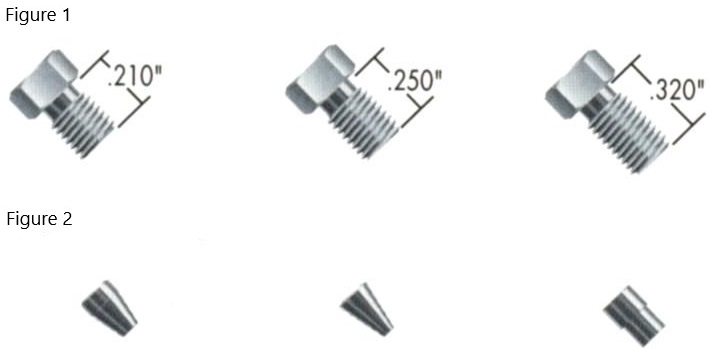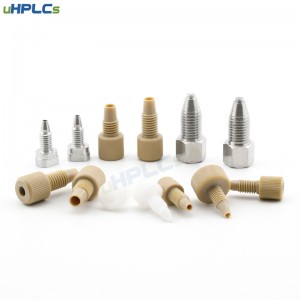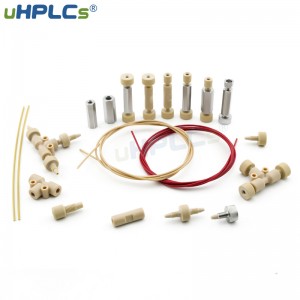Typical fittings consist of screws and ferrules designed to connect and seal the tubes. Despite their simple function, describing and using them is somewhat more complex. To describe a fitting exactly, several things need to be considered: the shape of the receiving hole (tapered or flat-low); what size of tube it fits; the thread of the screw, e.g., 10-32, 1/4-28, etc. (see thread definition and comparison of common threads in this chapter). Fittings can also be classified by unit of measure or by type of material.
The stainless steel fittings must be held together (or permanently attached) to the tube. We recommend the following processing steps.
First, fit the screws and ferrules to the tube in sequence, then attach them to the matching aperture and tighten the screws by hand while ensuring that the tube has reached the bottom of the aperture. Finally, use a spanner to turn another 3/4 of a buckle. Please note: the ferrule is now permanently fixed to the tube and can only be used in the bore if it is held tight. Incorrect use will result in dead volume and leaks (see next page). To tighten the pre-held stainless steel fittings correctly, we recommend using a spanner to tighten the 1/4 or 3/4 buckle again after hand tightening. In case of leakage, tighten the fitting a little more until the leakage stops. If the fitting still needs to be rotated for more than one week after hand tightening, we recommend replacing it, over tightening can cause damage to the product.

Unlike stainless steel, polymer fittings are almost universal in the equipment and are relatively simple to use, which is why they are becoming increasingly popular. Polymer fittings are not permanently attached to the tube and usually do not require tools (other than your fingers) to fasten them. In addition, these fittings are manufactured from a wide range of polymeric materials, offering a wide choice of prices and compatible solvents.

What happens if a fitting leaks?
1. Check the HPLC tubes to make sure they are properly connected. When using a normal hand-turned fitting, the tube must be fully threaded through the fitting before it is tightened with screws and ferrules. If the tube moves when the fitting is tightened and pulled gently, the screw and ferrule will need to be reinstalled.
2. The fitting may not have been tightened sufficiently. Stainless steel screws and ferrules must be tightened with a spanner even if used again. Hand-turned fittings also need to be tightened with force. However, a spanner should not be used unless required by the instructions. Otherwise, the fitting will be damaged.

You may have used incompatible fittings. Make sure that the screws and ferrules you are using are compatible with each other and with the fittings in your system. One way to avoid this problem is to use our universal hand screw fittings. As the ferrules will not always squeeze the tube, one-hand screw fitting can be reused in most systems. 4.
4. Check the condition of the screws and ferrules. After repeated use, the screws (especially the ferrules) will gradually deform and eventually fail to function as designed for sealing. It is a good idea to have extra screws and ferrules so they can be replaced quickly to avoid unnecessary slackening of work.
Sometimes leaks are not caused by screws and ferrules but by the receiving holes, especially those connected to stainless steel fittings. Please check the fittings and threads for visible scratches and replace them if necessary.
6. If you use fittings made of materials incompatible with the flowing phase, this will certainly cause leaks and may result in permanent damage to the fittings. Please refer to the solvent compatibility table in this chapter.
Warning signs of a leaking system
Before you see the first drop of fluid leaking from a fitting, the system will show a number of signals to tell you that something is wrong:.
1) There is no fluid flow and no pressure.
2) Increased pump pressure, but no fluid flowing through.
3) Baseline noise
4) Baseline drift
Of course, these signals can also indicate problems that are not related to leaking fittings at all, but it is easiest to start with the fittings first. Not only are fittings easy to repair but they are the cheapest component of the system that can cause trouble.
Post time: Feb-02-2023






